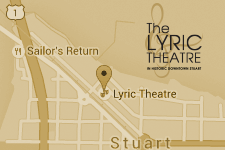The Lyric Theatre Presents
Peter Pertis
Peter Pertis is an internationally acclaimed Hungarian pianist. During his career of over forty years, he has played to enthusiastic audiences in 50 cities of 22 countries on five continents, including major concert halls such as Wigmore Hall (London), Carnegie Hall (New York), Casals Hall (Tokyo), and the Great Hall of the Franz Liszt Academy of Music (Budapest).
The fifth-generation disciple of great Hungarian pianist and composer Franz Liszt, Pertis was born into a talented family of musicians in his native city of Budapest. He has traveled the world, performing everywhere from Australia to South America, where critics have described the talented pianist as “a driving force with a lyrical sensitivity.” Pertis approaches each performance with a deep focus and poetic lyricism.
Peter graduated from Bela Bartok Conservatory of Music, and was immediately admitted into the Piano Department at the Franz Liszt Academy of Music. He received his doctorate from the prestigious academy, where he would later serve as a Professor of Piano. Pertis won the Bartok National Piano Competition in Budapest in 1960. The up-and-coming pianist defected from his country of Hungary in 1978 during the Cold War. However, he finally returned in 1996 to overwhelming critical acclaim. Pertis eventually became an artist of the National Concert Management of Hungary and became the first Hungarian pianist to record Moussorgsky’s “Pictures of an Exhibition.”
Aside from his international touring schedule, Peter Pertis has dedicated his time and energy to his role as an educator, teaching the art of the piano across the globe. Pete has worked as a professor at the Hart School of Music in Connecticut and as a guest professor at Trinity College. When he was offered a chance to teach at the Musashino Academy of Music in Tokyo, Peter moved his wife and 6-year old son to Japan in order to teach future national and international competition winners and award recipients. Many of his former students are now teachers themselves, educating students at renowned music academies around the world.
Pertis has decided to settle down in the past few years, always improving his incredible technical skills. The veteran pianist spends his time between Budapest and Stuart, Florida which he made his home after visiting the welcoming community of Martin County. Peter brings his world-famous technical ability to his fellow residents of Stuart downtown at the Lyric Theatre this January.
* * * * * * *
Beethoven's Piano Sonata op.31, No.2, was composed in 1801/02. It is usually referred to as "The Tempest" (or Der Sturm in his native German). As Beethoven's contemporaries say, the sonata was inspired by Shakespeare's play.
The first movement is in the classical sonata form. Moments of peacefulness with extensive passages of turmoil, after some time expanding into a haunting "storm" in which the peacefulness is lost. There is a recitative section at the middle of the movement's as a lonely human voice would be singing - or praying - alone.
The second movement in B flat major is slower and dignified. It mirrors the opening of the first movement as the use of a rolling recitative-like arpeggio on the first chord, which gives an opening for a large scale melody.
The third movement is a sonata-rondo, always moving, and flowing with emotion.
Chopin’s Ballade No. 1. Op. 23 is the first of the composer’s four ballades for solo piano. It was composed in 1835-36 during the composer’s early days in Paris. The ballade is a form of music that Chopin, himself, invented and in which he communicated with every extreme emotions. A typical Chopin ballade begins with a sweet, lyrical melody and the music becomes more forlorn, as the melody develops. The ballades are one-movement pieces for solo piano, and they are some of the most challenging pieces in the standard piano repertoire.
This piece is very narrative and has a strong feeling of intimacy. Chopin seemed to have been fond of his own g-minor Ballade. One of the composer’s good friends recalled his words about his ballade: “I like it the most and hold it as the dearest.”
Chopin’s Scherzo, op.31. No.2 was composed and published in 1837. It gives all of the sensitivity, beautiful melodies, power, motion, character, and virtuosity, we all enjoy in Chopin’s music. Robert Schumann compared this scherzo to a Byronic poem, "so overflowing with tenderness, boldness, love and contempt. What a masterly writing, and it lies in the very heart of the piano! A hundred generations may not improve on these pages.“ And he was perfectly right.
- - - - - - - - - Intermission - - - - - - - -
Liszt’s Vallée d'Obermann is the sixth piece from the collection of his stay in Switzerland during 1835-36. However, this piece is not the musical representation of a landscape, but an emotional experience inspired by the French writer F. Sénancour's Obermann (1804), a popular romantic novel at that time.
Obermann is a person with a melancholy character, who became very disappointed of the society and went to be living alone in the Swiss Alps. Liszt's composition is a musical transformation of the sentimental nature of this novel and its hero, Obermann, who goes through in different stages of his loneliness, first being philosophical, later going through storms, and begins to believe again in human nature, and God.
Liszt’s Mephisto Waltz had been named and inspired by the German Faust legend. It is a devilish, whirling dance, showing off Franz Liszt's dazzling mastery of energy, and virtuosity. The Mephisto Waltz is one of the most famous work of Liszt's, because it shows the composer's super-virtuoso musical style. It's a mysterious masterpiece, full of exciting, warmth and brightness. It sounds modern even today.
Thank you for supporting The Lyric Theatre, see you at the show!

